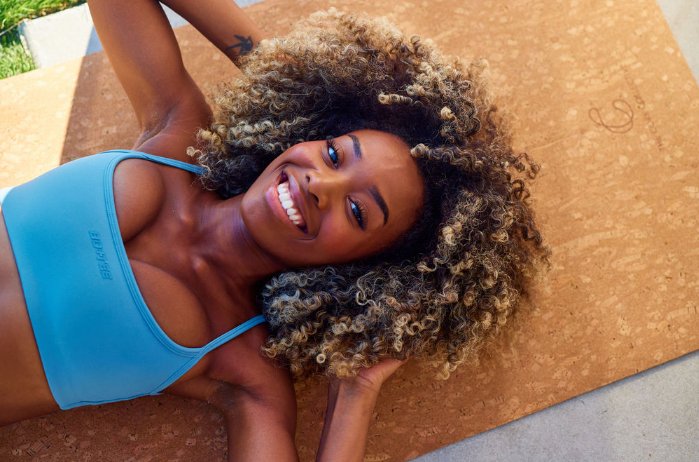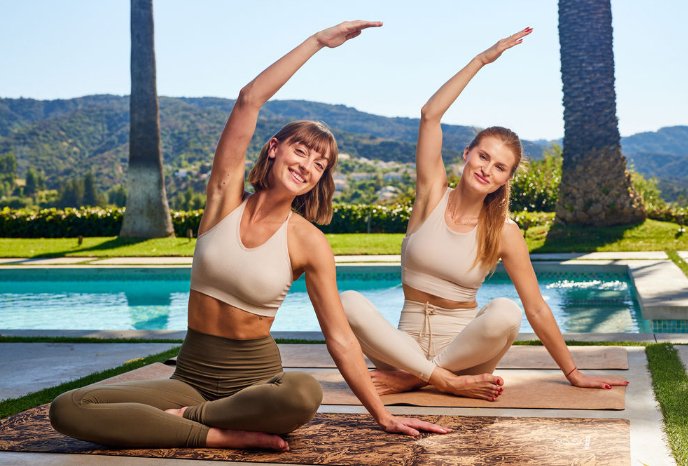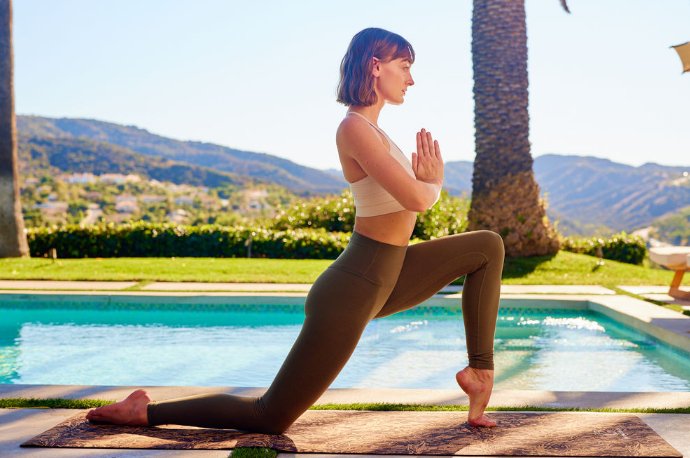Introduction:
Are you tired of that persistent, nagging calf pain that disrupts your day and hampers your activities? You're not alone. Calf tension is a common issue that many people face, often caused by factors like overuse, poor posture, or simply the wear and tear of daily life. But what if there was a simple, natural way to find relief? Enter yoga—a centuries-old practice known for its incredible benefits to the mind and body. In this blog, we’ll explore how yoga can be your go-to solution for alleviating calf tension. From understanding the root causes to discovering the most effective yoga poses, you’ll learn everything you need to know to say goodbye to calf pain and hello to a more flexible, pain-free life. Let's dive in and find out how these yoga moves can transform your well-being!
Understanding Calf Tension and Its Causes
What are the calf muscles
The calf is composed of two main muscles: the gastrocnemius, which has a teardrop shape on the back of the lower leg, and the soleus, a flat muscle located beneath the gastrocnemius.
When you walk, both muscles contract to lift the heel and dorsiflex the foot (bringing the toes toward the face), allowing you to land on the heel first and then roll onto the ball of the foot mid-stride. In mindful walking, you can feel these muscles in both legs working, noticing the sensations as they lengthen and contract with each step.
In various yoga poses, the calf muscles lengthen to keep the heels grounded. When the knee is straight, the gastrocnemius is the main muscle involved in plantar flexion, which points the toes downward. When the knee is bent, the soleus takes over this function.
Our bodies function as a kinetic chain, so neglecting tight calves can cause knee and hip pain. The gastrocnemius must be flexible to allow proper dorsiflexion of the foot. If the calves are constantly tight, continued walking and exercise will worsen the issue, making stretching essential.
Common Causes of Calf Tension
Several factors can contribute to calf tension. Common causes include strenuous physical activities such as running or cycling, inadequate warm-up routines before exercise, and insufficient stretching after workouts. Additionally, wearing improper footwear and maintaining poor posture can also lead to calf tension. Identifying these causes can help in adopting the right yoga practices to alleviate the discomfort.
The Benefits of Using Yoga for Calf Pain Relief
Yoga is a holistic practice that offers numerous benefits for relieving calf tension. By incorporating specific yoga poses into your routine, you can enhance flexibility, improve blood circulation, and reduce muscle tightness. Yoga not only helps in stretching the calf muscles but also promotes overall relaxation and well-being. Regular practice of yoga can lead to significant improvements in managing and preventing calf pain.
Essential Yoga Poses to Relieve Calf Tension
Downward Facing Dog (Adho Mukha Svanasana)
Downward Facing Dog is a fundamental yoga pose that stretches the hamstrings, calves, and spine, while also strengthening the arms and shoulders. Here are the specific steps to perform this pose:
Start on Your Hands and Knees:
- Begin in a tabletop position with your wrists directly under your shoulders and your knees directly under your hips.
- Spread your fingers wide and press evenly through your palms.
Tuck Your Toes:
-
Curl your toes under so that the soles of your feet are pressing into the mat.
Lift Your Hips:
- As you exhale, lift your knees off the floor and straighten your legs as much as you can. Your body should form an inverted "V" shape.
- Keep your knees slightly bent if your hamstrings are tight.
Position Your Hands and Feet:
- Walk your hands forward a few inches and your feet back a few inches to lengthen the spine and create more space.
- Your feet should be hip-width apart and your hands shoulder-width apart.
Engage Your Muscles:
-
Press your palms firmly into the mat, especially through the bases of your index fingers and thumbs.
-
Rotate your upper arms outward to broaden your shoulders.
-
Engage your quadriceps and lift your kneecaps to keep your legs active.
Align Your Body:
-
Draw your chest toward your thighs without rounding your back.
-
Keep your head between your upper arms, not letting it hang.
-
Relax your neck and look toward your navel or between your legs.
Breathe:
-
Take deep, even breaths. Hold the pose for five to ten breaths, or as long as comfortable.
Release the Pose:
-
To come out of Downward Facing Dog, slowly lower your knees to the floor and return to the tabletop position or move into Child's Pose for a rest.
Standing Forward Bend (Uttanasana)
Standing Forward Bend (Uttanasana) is a foundational yoga pose that stretches the hamstrings, calves, and back, while also calming the mind and relieving stress. Here are the specific steps to perform this pose:
Start in Mountain Pose (Tadasana):
-
Stand with your feet hip-width apart or together, grounding evenly through all four corners of your feet.
-
Engage your quadriceps and lift your kneecaps.
-
Lengthen your spine and roll your shoulders down and back.
-
Keep your arms relaxed at your sides.
Inhale and Lengthen:
-
As you inhale, reach your arms overhead to lengthen your spine.
-
Lift through your chest and extend through the crown of your head.
Exhale and Fold Forward:
-
As you exhale, hinge at your hips and fold forward over your legs.
-
Keep your spine long as you fold, leading with your chest rather
Reclining Hand-to-Big-Toe Pose (Supta Padangusthasana)
Start on Your Back:
-
Lie down on your back with your legs extended and your arms resting by your sides.
-
Ensure your spine is in a neutral position and your body is aligned.
Bend Your Right Knee:
-
Draw your right knee into your chest, keeping your left leg extended and pressing into the mat.
Grab Your Big Toe:
-
Loop a yoga strap around the arch of your right foot if you can't reach your toe directly. Hold the strap with both hands.
-
If you can reach, use your right hand to grab the big toe of your right foot with your first two fingers and thumb (yogic toe lock).
Extend Your Right Leg:
-
Slowly extend your right leg toward the ceiling, keeping your foot flexed and your left leg active and pressing into the mat.
-
If using a strap, walk your hands up the strap to bring your leg closer to a vertical position.
Align Your Body:
-
Ensure your hips are level and your lower back is pressing gently into the mat.
-
Keep your shoulders relaxed and away from your ears.
Hold the Pose:
-
Stay in the pose for 5-10 breaths, breathing deeply and allowing the stretch to deepen with each exhale.
-
Focus on keeping your extended leg straight and active, and avoid locking your knee.
Switch Sides:
-
To release, bend your right knee and gently lower it back to the mat.
-
Repeat the pose on the left side by drawing your left knee into your chest and following the same steps.
Hero Pose (Virasana) with Calf Stretch
Start in a Kneeling Position:
-
Kneel on the floor with your knees together and your thighs perpendicular to the floor.
-
Keep your feet slightly wider than your hips, with the tops of your feet flat on the floor and your big toes pointing straight back.
Sit Back Between Your Heels:
-
Slowly lower your hips to sit between your heels. Ensure that your heels are close to your hips and your toes are pointing backward.
-
If this is uncomfortable or if your hips do not reach the floor, place a block or folded blanket between your heels and sit on it for support.
Adjust Your Feet for a Calf Stretch:
-
For a deeper calf stretch, lift your knees slightly off the floor and tuck your toes under, so the soles of your feet are pressing into the mat.
-
Sit back onto your heels, keeping your weight evenly distributed between your feet and your sitting bones.
Align Your Body:
-
Ensure your spine is straight and your shoulders are relaxed.
-
Place your hands on your thighs or in your lap, palms facing down or up.
Breathe Deeply:
-
Take deep, even breaths. As you inhale, lengthen through your spine. As you exhale, relax into the stretch.
-
Hold the pose for 30 seconds to a minute, or longer if comfortable.
Release the Pose:
-
To come out of the pose, lean forward slightly and lift your hips.
-
Gently untuck your toes and return to a kneeling position.
-
If you used a block or blanket, remove it and come back to a comfortable seated position.
Tips for Effective Yoga Practice for Calf Pain Relief
Warm-Up and Cool-Down Routines
Incorporating proper warm-up and cool-down routines is essential for an effective yoga practice. Before starting your yoga session, engage in light activities such as brisk walking or gentle jogging to increase blood flow to your muscles. After your yoga practice, perform gentle stretches to cool down and prevent muscle soreness. These routines enhance the benefits of yoga for calf pain relief.
Proper Breathing Techniques
Breathing plays a crucial role in yoga practice. Proper breathing techniques help in maximizing the benefits of each yoga pose. Focus on deep, diaphragmatic breathing to enhance relaxation and improve oxygen flow to your muscles. Synchronize your breath with your movements to create a harmonious yoga practice that effectively relieves calf tension.
Consistency and Patience: Key to Long-Term Relief
Consistency and patience are vital for experiencing long-term relief from calf tension through yoga. Incorporate yoga into your daily routine, even if it’s just for a few minutes. Over time, regular practice will lead to improved flexibility and reduced muscle tightness. Be patient with your progress and listen to your body’s needs, allowing yoga to work its magic in relieving calf pain.
Conclusion:
Calf tension can be a real pain,but incorporating yoga into your routine can offer much-needed relief. By understanding the causes of calf tension and practicing targeted yoga poses like Downward Facing Dog, Standing Forward Bend, Reclining Hand-to-Big-Toe Pose, and Hero Pose with a calf stretch, you can alleviate discomfort and improve your overall flexibility. Remember to follow warm-up and cool-down routines, practice proper breathing techniques, and be consistent and patient with your yoga practice.
Ready to start your journey to a pain-free life? Try these yoga moves and feel the difference. To make your practice even more enjoyable, we're offering an exclusive discount on our premium yoga mats. Use code BestCorkYogaMat at checkout for 15% off your purchase. Don’t let calf pain hold you back any longer—embrace the power of yoga today!





Leave a comment
This site is protected by hCaptcha and the hCaptcha Privacy Policy and Terms of Service apply.